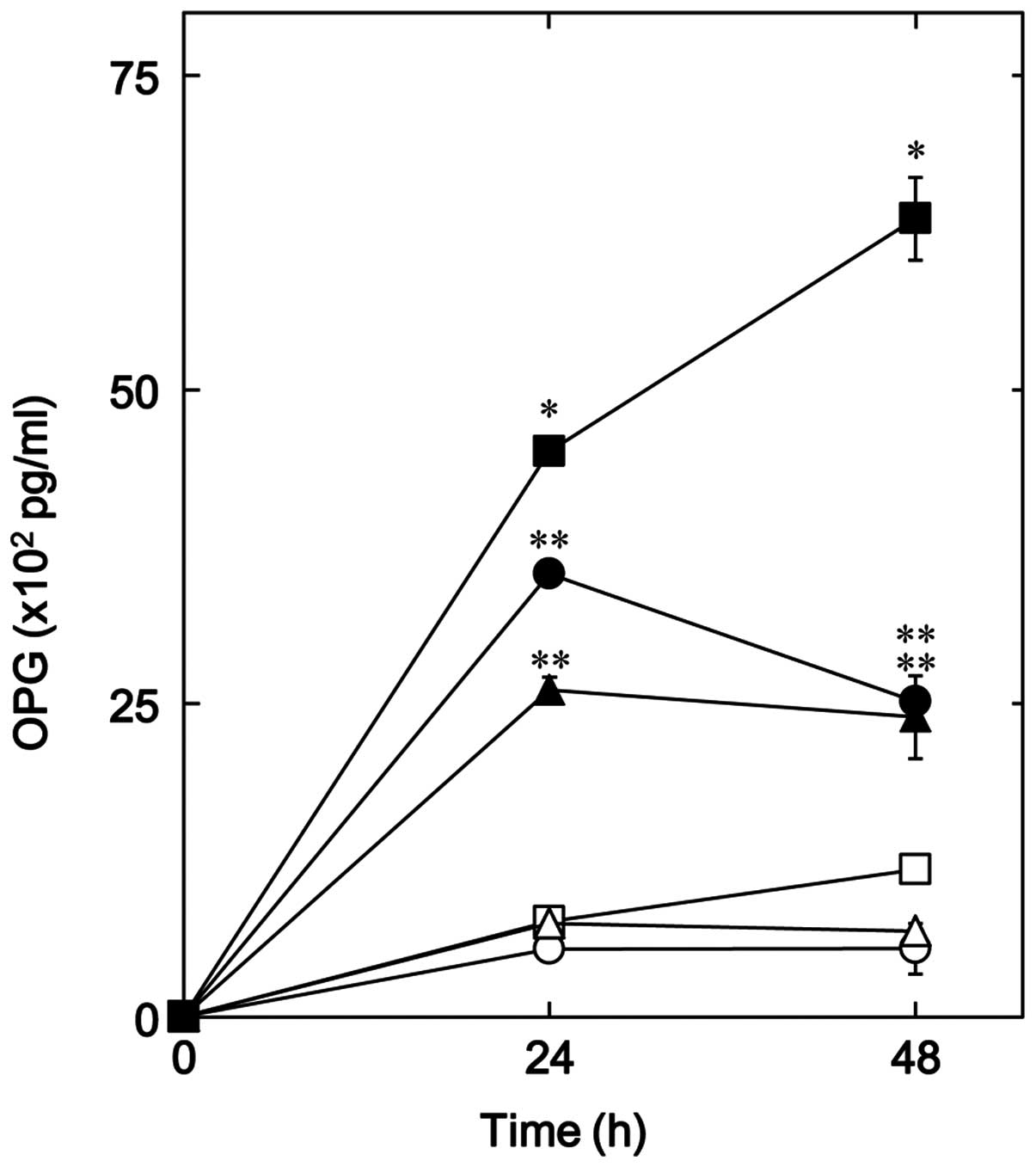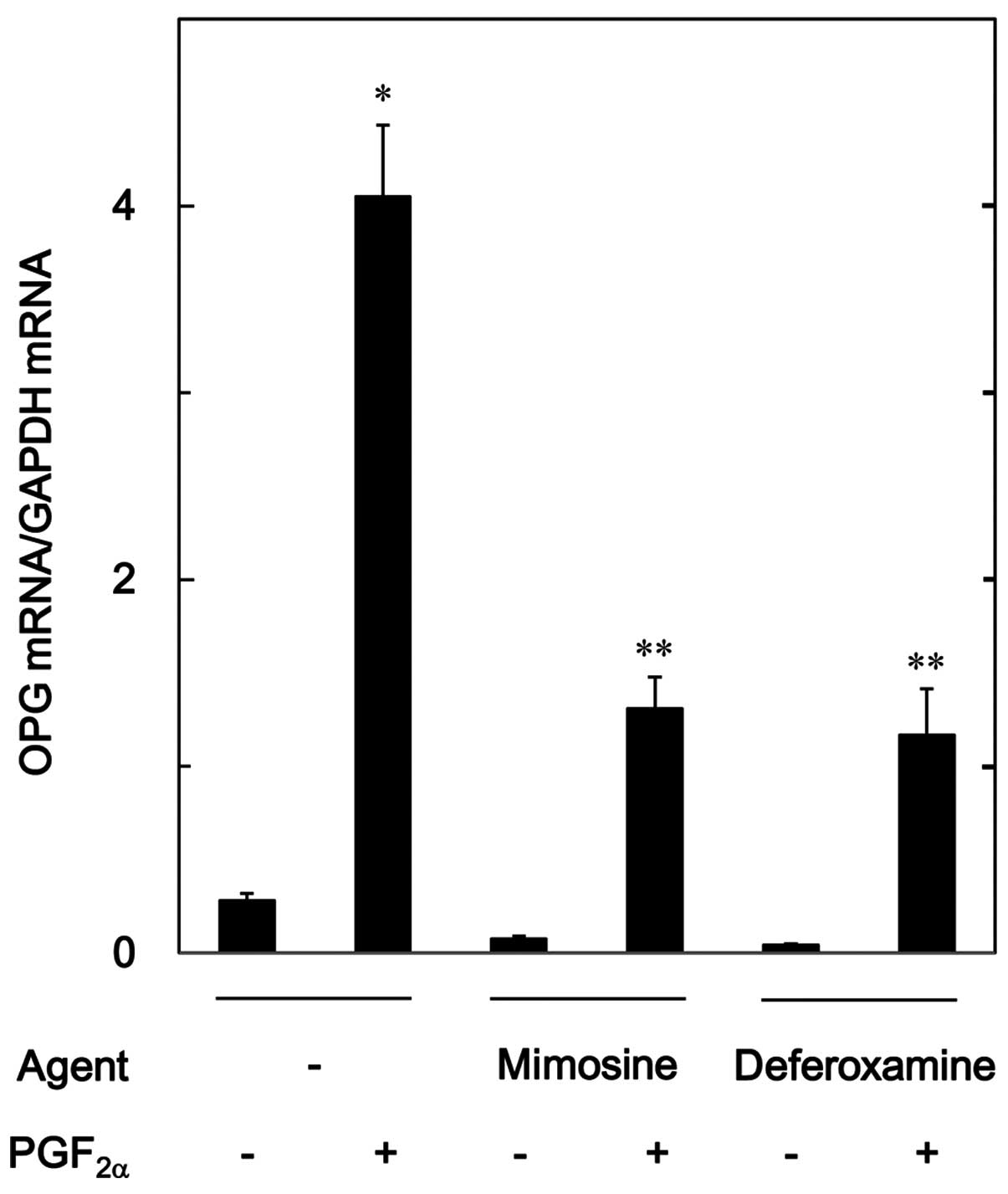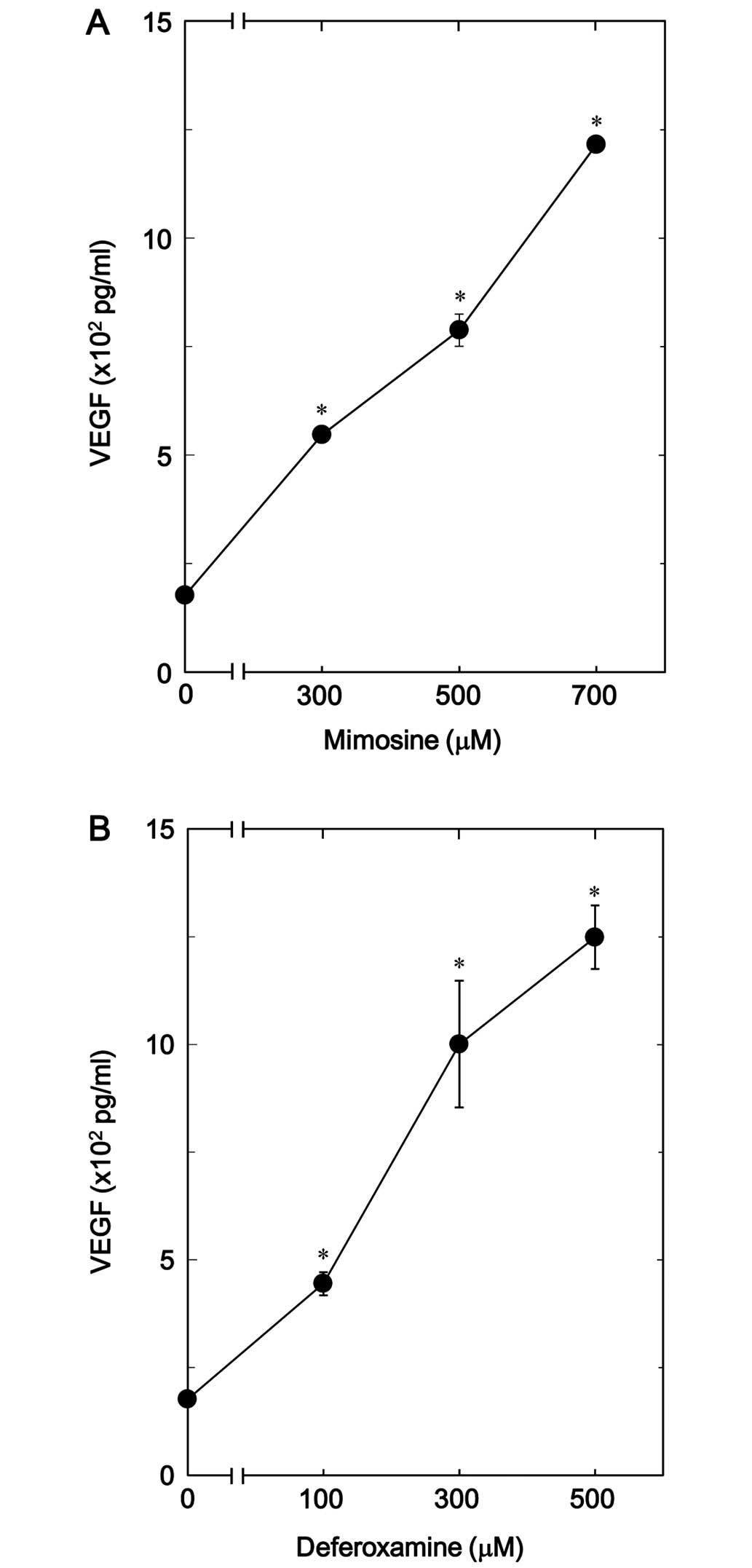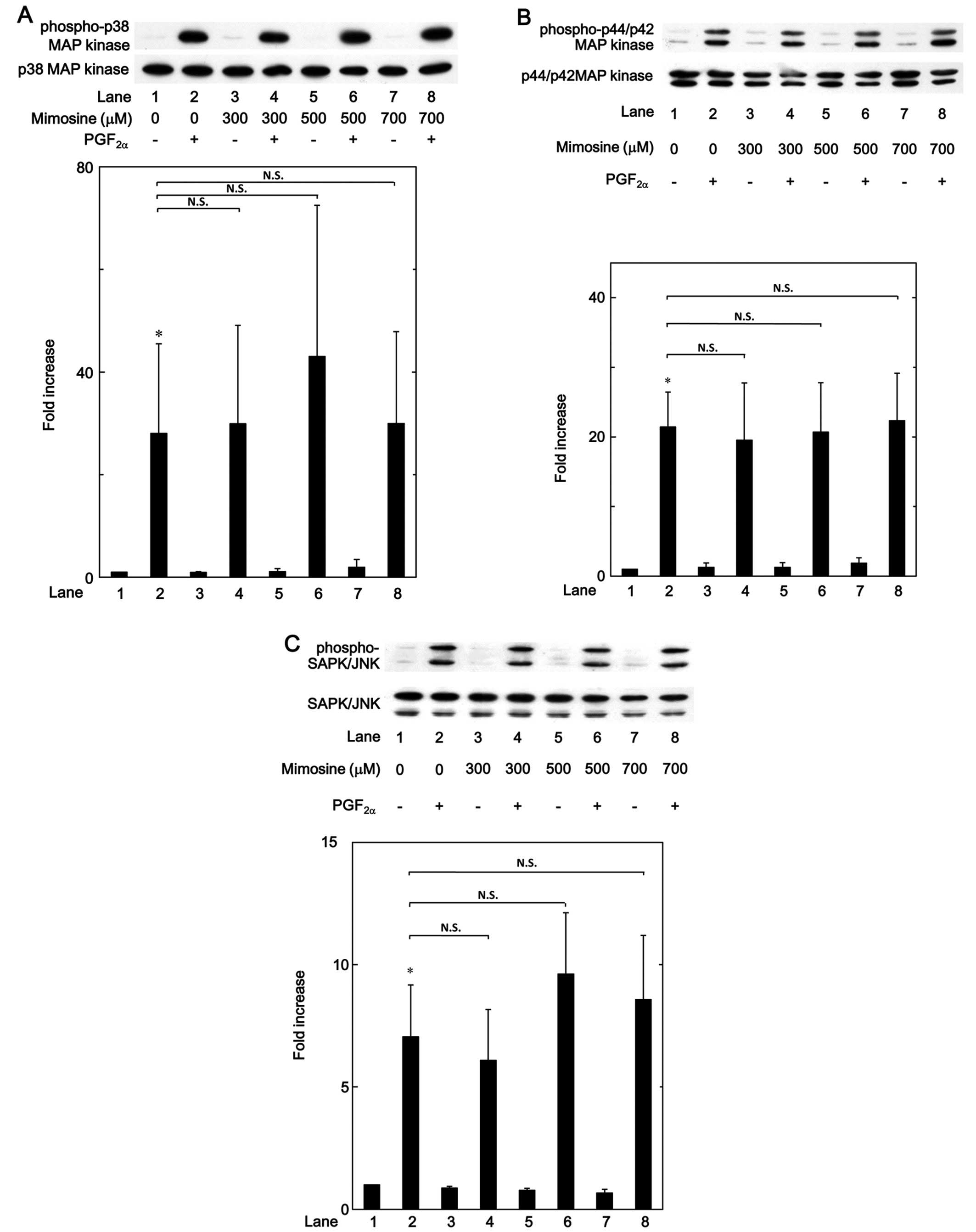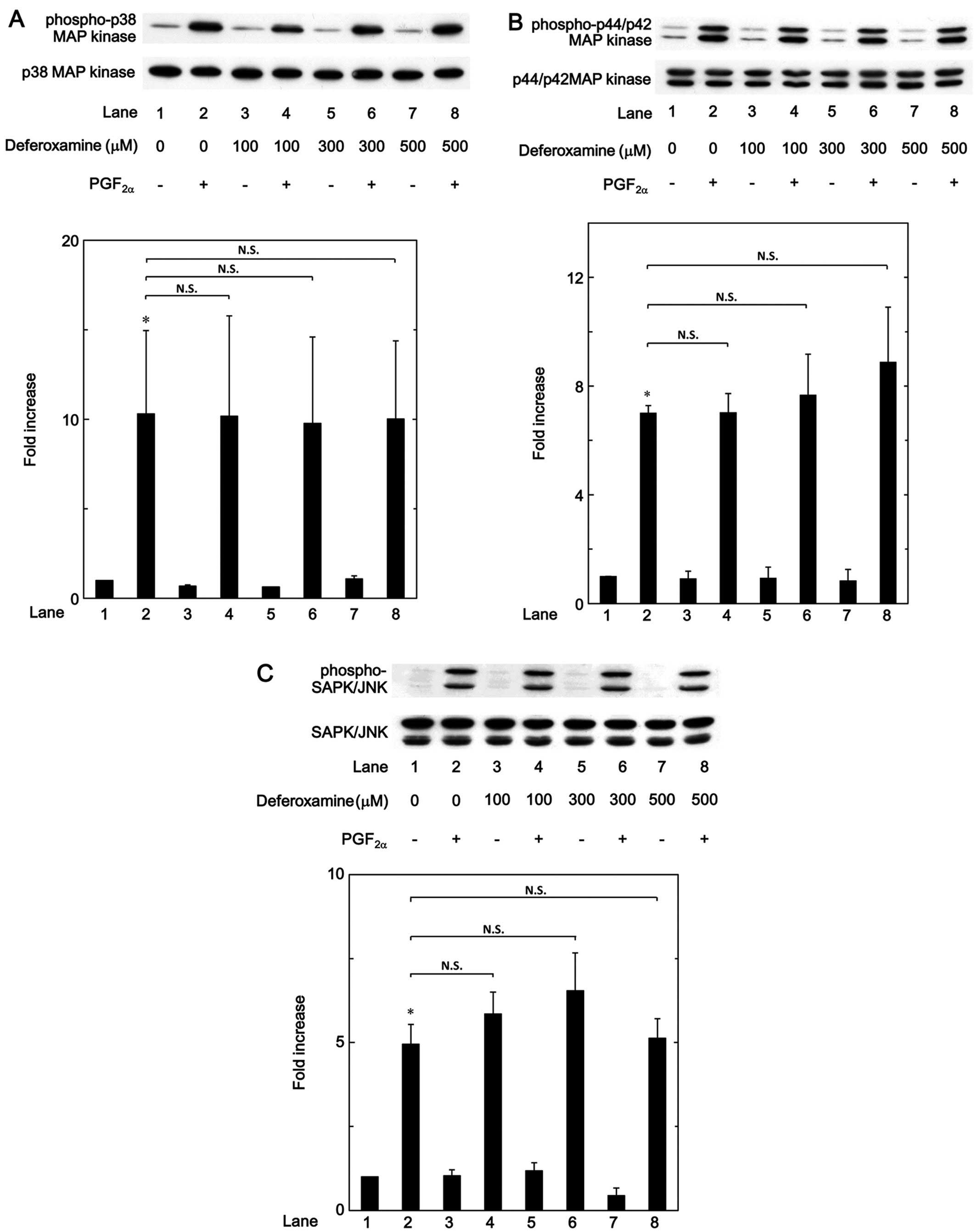Mimosine suppresses the PGF2α-induced synthesis of osteoprotegerin but not interleukin-6 in osteoblasts
- Authors:
- Published online on: January 7, 2016 https://doi.org/10.3892/ijmm.2016.2452
- Pages: 533-541
Abstract
Introduction
Bone metabolism is regulated strictly by two types of functional cells, osteoblasts and osteoclasts, which are responsible for bone formation and bone resorption, respectively (1). Bone remodeling is known to be the outcome of the coupling and fine-tuning process of osteoblastic bone formation and osteoclastic bone resorption (1). Numerous humoral factors, including cytokines and prostaglandins, have been demonstrated to participate in bone remodeling (2). Osteoprotegerin, which belongs to the tumor necrosis factor receptor family, along with receptor activator of nuclear factor-κB (RANK), is synthesized by osteoblasts and plays an inhibitory role in osteoclastic differentiation and activation (3). Osteoprotegerin, secreted by osteoblasts, binds to RANK ligand (RANKL) as a decoy receptor, and prevents RANKL from binding to RANK, resulting in the inhibition of bone resorption (3). It has been reported in previous research that RANKL knock-out mice and osteoprotegerin knock-out mice suffered from severe osteopetrosis and osteoporosis, respectively (4,5). Therefore, it has been firmly established that the RANK/RANKL/osteoprotegerin axis is a major regulatory aspect of bone remodeling (6).
It has previously been noted that prostaglandins act as autacoids in osteoblasts (7). Prostaglandins, which have previously been recognized as potent bone-resorptive agents (8), are known to play important roles also in the process of bone formation (8,9). Of the prostaglandins, prostaglandin F2α (PGF2α) has been shown to act as a bone remodeling mediator (9). In relation to osteoblasts, we have previously demonstrated that PGF2α induces activation of p38 mitogen-activated protein (MAP) kinase, p44/p42 MAP kinase and stress-activated protein kinase/c-Jun N-terminal kinase (SAPK/JNK) in osteoblast-like MC3T3-E1 cells, and that PGF2α-induced osteoprotegerin synthesis is mediated through these MAP kinases (10). We have also shown that PGF2α stimulates the synthesis of interleukin-6 (IL-6), a multifunctional cytokine modulating bone metabolism (11,12), via the activation of p38 MAP kinase and p44/p42 MAP kinase but not SAPK/JNK in osteoblast-like MC3T3-E1 cells (13,14). However, the details of the effects of PGF2α on osteoblasts still remain unclear.
Mimosine, a plant amino acid, is well known to chelate iron and inhibit mammalian DNA replication (15). Mimosine is additionally recognized as a normoxic inducer of hypoxia-inducible factor (HIF) (16). HIF is a DNA-binding transcription factor that interacts with specific nuclear cofactors under low oxygen conditions, and activates a series of hypoxia-associated genes to facilitate responses to hypoxic environments (17). A large number of target genes of HIF have been identified, e.g., erythropoietin, glucose transporter protein 1 and vascular endothelial growth factor (VEGF) (16). HIF is known to play an important role in angiogenesis, erythropoiesis and metabolism (16). Regarding HIF and bone metabolism, it has been previously demonstrated that hypoxia regulates osteoclast-mediated bone resorption (17). In osteoblasts, HIF-1α reportedly promotes bone formation by direct stimulation of osteoblast proliferation (18). Additionally, HIF-1α promotes angiogenesis and stimulates bone regeneration (19). However, the exact role of HIF in bone metabolism has not yet been clarified.
In the present study, we investigated the effect of mimosine, a normoxic inducer of HIF, on the PGF2α-induced synthesis of osteoprotegerin and IL-6, and the exact mechanism in osteoblast-like MC3T3-E1 cells. Herein, we show that that mimosine suppresses the PGF2α-induced osteoprotegerin synthesis without affecting IL-6 synthesis in these cells.
Materials and methods
Materials
Mimosine and deferoxamine were purchased from Sigma-Aldrich Co. (St. Louis, MO, USA). A mouse osteoprotegerin enzyme-linked immunosorbent assay (ELISA) kit, mouse IL-6 ELISA kit, mouse VEGF ELISA kit and PGF2α were obtained from R&D Systems, Inc. (Minneapolis, MN, USA). HIF-1α antibodies (ab16066) were obtained from Abcam (Cambridge, UK). Phospho-specific p38 MAP kinase antibodies (#4511), p38 MAP kinase antibodies (#9212), phospho-specific p44/p42 MAP kinase antibodies (#9101), p44/p42 MAP kinase antibodies (#9102), phospho-specific SAPK/JNK antibodies (#4671) and SAPK/JNK antibodies (#9252) were all obtained from Cell Signaling Technology, Inc. (Beverly, MA, USA). Actin antibodies were obtained from Santa Cruz Biotechnology, Inc. (Santa Cruz, CA, USA). An ECL western blot detection system was obtained from GE Healthcare (Buckinghamshire, UK). Other materials and chemicals were obtained from commercial sources. PGF2α was dissolved in ethanol. Mimosine was disolved in phosphate-buffered saline (PBS) supplemented with 0.01% bovine serum albumin (BSA) containing 7.5% NaHCO3. Deferoxamine was disolved in PBS supplemented with 0.01% BSA. The maximum concentration of ethanol was 0.1%, which did not affect the assay for osteoprotegerin release, IL-6 release, osteoprotegerin mRNA expression, or western blot analysis.
Cell culture
Cloned osteoblast-like MC3T3-E1 cells derived from newborn mouse calvaria (20) were maintained as previously described (21). Briefly, the cells were cultured in α-minimum essential medium (α-MEM) containing 10% fetal bovine serum (FBS) at 37°C in a humidified atmosphere of 5% CO2/95% air. The cells were seeded into 35-mm diameter dishes (5×104 cells/dish) or 90-mm diameter dishes (2×105 cells/dish) in α-MEM containing 10% FBS. After 5 days, the medium was exchanged for α-MEM containing 0.3% FBS. The cells were then used for experiments after 48 h.
Assay for osteoprotegerin or IL-6
The cultured cells were pretreated with various doses of mimosine or deferoxamine for 60 min, and then stimulated with 10 µM PGF2α or the vehicle (PBS supplemented with 0.01% BSA containing 0.1% ethanol) in 1 ml of α-MEM containing 0.3% FBS for the indicated periods of time. The conditioned medium was collected at the end of incubation, and the concentrations of osteoprotegerin or IL-6 were subsequently measured using an osteoprotegerin ELISA kit or IL-6 ELISA kit according to the manufacturer's instructions.
Assay for VEGF
The cultured cells were treated with various doses of mimosine or deferoxamine in 1 ml of α-MEM containing 0.3% FBS for 48 h. The conditioned medium was collected at the end of incubation, and the VEGF concentrations were then measured using a VEGF ELISA kit according to the manufacturer's instructions.
Reverse transcription-quantitative PCR (RT-qPCR)
Cultured cells were pretreated with 700 µM mimosine, 500 µM deferoxamine or vehicle for 60 min, and then stimulated with 10 µM PGF2α or vehicle in α-MEM containing 0.3% FBS for 3 h. Total RNA was isolated and transcribed into cDNA using TRIzol reagent (Invitrogen Co., Carlsbad, CA, USA) and an Omniscript Reverse Transcriptase kit (Qiagen, Inc., Valencia, CA, USA), respectively. RT-qPCR was performed using a LightCycler system with capillaries and the FastStart DNA Master SYBR-Green I provided with the kit (Roche Diagnostics, Basel, Switzerland). Sense and antisense primers for mouse osteoprotegerin mRNA were purchased from Takara Bio, Inc. (Tokyo, Japan) (primer set ID: OPG; MA026526) (osteoprotegerin primer sequences (5′→3′): forward, CAATGGCTGGCTTGGTTTCATAG and reverse, CTGAACCAGACATGACAGCTGGA), whereas mouse VEGF mRNA or glyceraldehyde-3-phosphate dehydrogenase (GAPDH) mRNA primers were synthesized based on the study of Simpson et al (22) (VEGF primer sequences (5′→3′): forward, TTACTGCTGTACCTCCACC and reverse, ACAGGACGGCTTGAAGATG; and GAPDH primer sequences (5′→3′) forward, AACGACCCCTTCATTGAC and reverse, TCCACGACATACTCAGCAC. The amplified products were determined using a melting curve analysis and agarose gel electrophoresis. The mRNA levels of osteoprotegerin or VEGF were normalized to those of GAPDH mRNA, respectively.
Western blot analysis
The cultured cells were pretreated with various doses of mimosine or deferoxamine for 60 min, and then stimulated with 10 µM PGF2α or vehicle in α-MEM containing 0.3% FBS for the indicated periods of time. The cells were washed twice with phosphate-buffered saline, and then lysed, homogenized and sonicated in a lysis buffer containing 62.5 mM Tris/HCl, pH 6.8, 2% sodium dodecyl sulfate (SDS), 50 mM dithiothreitol and 10% glycerol. SDS-polyacrylamide gel electrophoresis (PAGE) was performed according to the method of Laemmli (23) in 10% polyacrylamide gels. The protein was fractionated and transferred onto Immun-Blot PVDF membranes (Bio-Rad, Hercules, CA, USA). The membranes were blocked with 5% fat-free dry milk in Tris-buffered saline-Tween-20 (TBS-T; 20 mM Tris-HCl, pH 7.6, 137 mM NaCl, 0.1% Tween-20) for 1 h before incubation with primary antibodies. Western blot analysis was performed as described previously (24) using HIF-1α antibodies, actin antibodies, phospho-specific p38 MAP kinase antibodies, p38 MAP kinase antibodies, phospho-specific p44/p42 MAP kinase antibodies, p44/p42 MAP kinase antibodies, phospho-specific SAPK/JNK antibodies or SAPK/JNK antibodies as primary antibodies, and peroxidase-labeled antibodies raised in goat anti-rabbit IgG were used as secondary antibodies (074-1506, KPL, Inc., Gaithersburg, MD, USA). The primary and secondary antibodies were diluted at 1:1,000 with 5% fat-free dried milk in TBS-T. The peroxidase activity on the PVDF membranes was visualized on X-ray film by means of the ECL western blot detection system.
Densitometric analysis
Densitometric analysis was performed using scanner and image analysis software (ImageJ version 1.48; National Institutes of Health, Bethesda, MD, USA). The phosphorylated protein levels were calculated as follows: the background-subtracted signal intensity of each phosphorylation signal was normalized to the respective total protein signal and plotted as the fold increase in comparison to control cells which had not been stimulated by PGF2α nor treated with mimosine or deferoxamine.
Statistical analysis
The data were analyzed by ANOVA followed by the Bonferroni method for multiple comparisons between pairs, and a p-value <0.05 was considered to indicate a statistically significant difference. All data are presented as the means ± SEM of triplicate determinations from three independent cell preparations.
Results
Effects of mimosine and deferoxamine on HIF-1α protein levels in MC3T3-E1 cells
Mimosine, which is an inhibitor of the prolyl hydroxylase domain proteins responsible for degrading HIF-1α, is known to act a normoxic inducer of HIF-1α (25). In the present study, we first examined the effect of mimosine on HIF-1α protein levels in osteoblast-like MC3T3-E1 cells. We noted that mimosine markedly increased the HIF-1α protein levels (Fig. 1A).
It has previously been noted that deferoxamine, an iron chelator, exerts its angiogenic effects through stimulation of the HIF-1α pathway (26), and deferoxamine is known to be another inducer of HIF-1α (26). We also found that HIF-1α protein expression levels were markedly upregulated by deferoxamine (Fig. 1B).
Effects of mimosine and deferoxamine on PGF2α-induced osteoprotegerin release in MC3T3-E1 cells
We have recently shown that PGF2α stimulates osteoprotegerin synthesis in osteoblast-like MC3T3-E1 cells (10). Thus, in the present study we examined the effect of mimosine and deferoxamine on PGF2α-induced osteoprotegerin release in MC3T3-E1 cells. Mimosine was noted to significantly reduce osteoprotegerin release induced by PGF2α up to 48 h (Fig. 2). The suppressive effect of mimosine on osteoprotegerin release is clearly dose-dependent in the range between 300 and 700 µM (Fig. 3A); mimosine at 500 µM caused a 65% decrease in PGF2α-induced OPG release. In addition, we also noted that deferoxamine significantly decreased the release of osteoprotegerin induced by PGF2α (Fig. 2), and the inhibitory effect was dose-dependent in the range between 100 and 500 µM (Fig. 3B). The maximum inhibitory effect of deferoxamine in relation to OPG release was observed at 500 µM, which caused approximately an 80% decrease in PGF2α-induced OPG release.
Effects of mimosine or deferoxamine on the PGF2α-induced release of IL-6 in MC3T3-E1 cells
We have previously reported that PGF2α stimulates IL-6 synthesis in osteoblast-like MC3T3-E1 cells (13,14). Thus, in the present study we examined the effect of mimosine or deferoxamine on the PGF2α-induced release of IL-6. It was clear that mimosine up to 700 µM failed to markedly affect the IL-6 release induced by 10 µM PGF2α (Fig. 4A). In addition, we noted that deferoxamine up to 500 µM did not markedly effect PGF2α (10 µM)-induced IL-6 release (Fig. 4B).
Effects of mimosine or deferoxamine on PGF2α-induced osteoprotegerin mRNA expression in MC3T3-E1 cells
To investigate whether the inhibitory effect of mimosine or deferoxamine on PGF2α-induced osteoprotegerin release is mediated by transcriptional events in osteoblast-like MC3T3-E1 cells, we examined the effect of mimosine and deferoxamine on PGF2α-induced osteoprotegerin mRNA expression. Mimosine (700 µM) and deferoxamine (500 µM), which alone hardly affected the osteoprotegerin mRNA level, significantly attenuated the increase in the mRNA expression level of osteoprotegerin induced by 10 µM of PGF2α (Fig. 5).
Effects of mimosine or deferoxamine on the release of VEGF and the expression of mRNA in MC3T3-E1 cells
It has been noted previously that HIF increases oxygen-regulated gene expression, including VEGF, and promotes angiogenesis and osteogenesis (27). Therefore, we examined whether mimosine or deferoxamine upregulates VEGF release in osteoblast-like MC3T3-E1 cells. The release of VEGF was significantly upregulated by mimosine in a dose-dependent manner in the range between 300 and 700 µM (Fig. 6A). Additionally, we noted that deferoxamine dose-dependently increased VEGF release in the range between 100 and 500 µM (Fig. 6B).
We further investigated the effects of mimosine or deferoxamine on VEGF mRNA expression in MC3T3-E1 cells. Both mimosine and deferoxamine significantly upregulated VEGF mRNA expression levels (Fig. 7).
Effects of mimosine or deferoxamine on PGF2α-induced phosphorylation of p38 MAP kinase, p44/p42 MAP kinase or SAPK/JNK in MC3T3-E1 cells
In a previous study, we have demonstrated that PGF2α-induced osteoprotegerin synthesis is mediated through activation of p38 MAP kinase, p44/p42 MAP kinase and SAPK/JNK in osteoblast-like MC3T3-E1 cells (10). Therefore, in the present study we examined whether mimosine and deferoxamine affected the PGF2α-induced phosphorylation of p38 MAP kinase, p44/p42 MAP kinase or SAPK/JNK in these cells. We noted that the phosphorylation of p38 MAP kinase, p44/p42 MAP kinase and SAPK/JNK induced by PGF2α was not markedly affected by mimosine, up to 700 µM (Fig. 8). It also became evident that deferoxamine exerted little effect on the PGF2α-induced phosphorylation of p38 MAP kinase, p44/p42 MAP kinase and SAPK/JNK, up to 500 µM (Fig. 9).
Discussion
In the present study, we demonstrated that mimosine significantly reduced the PGF2α-induced release of osteoprotegerin in osteoblast-like MC3T3-E1 cells. It is well known that mimosine is an inhibitor of the prolyl hydroxylase domain proteins responsible for degrading HIF-1α and also that it is an inhibitor of DNA replication (16,25). Additionally, we showed in the present study that the release of osteoprotegerin caused by PGF2α was significantly suppressed by deferoxamine, which is another inhibitor of the prolyl hydroxylase domain proteins responsible for degrading HIF-1α, as has also been previously stated (26). We found that the protein levels of HIF-1α were considerably upregulated by both mimosine and deferoxamine in osteoblast-like MC3T3-E1 cells. Thus, it seems likely that the inhibitory effect of mimosine or deferoxamine on osteoprotegerin release is mediated through the HIF-1α-dependent pathway in MC3T3-E1 cells. In addition, we demonstrated that both mimosine and deferoxamine suppressed the PGF2α-induced osteoprotegerin mRNA expression. Therefore, our findings suggest that the suppressive effect of mimosine and deferoxamine on PGF2α-induced osteoprotegerin release is exerted at a point upstream of the transcriptional level in these cells. It is important to note that HIF-1 is a transcription factor which plays a pivotal role in the cellular response to hypoxia, and that VEGF is a target gene of HIF-1 (16). In this study, we showed that mimosine and deferoxamine by themselves induced the release and the expression of VEGF mRNA. It has been noted that the HIF-1 consists of two subunits, HIF-1α and HIF-1β, and the expressed HIF-1α is degraded immediately in normoxic cells by the ubiquitin-proteasome system, and that chemical hydroxylase inhibitors including mimosine and deferoxamine suppress the degradation of HIF-1α, resulting in its stabilization (16,25,26). Therefore, it is probable that mimosine and deferoxamine, as normoxic inducers of HIF-1α, actually stimulate VEGF synthesis in MC3T3-E1 cells. Taken together, our findings suggest that mimosine and deferoxamine suppress the PGF2α-induced synthesis of osteoprotegerin via stabilization of HIF-1α expression in osteoblast-like MC3T3-E1 cells.
In our previous studies (13,14), we reported that PGF2α induces the synthesis of IL-6 and also osteoprotegerin in osteoblast-like MC3T3-E1 cells. IL-6 is known as a bone-resorptive cytokine, and it plays an important role in bone metabolism (6). Thus, we examined the effect of mimosine or deferoxamine on PGF2α-induced IL-6 release, and demonstrated that neither mimosine nor deferoxamine affected the release of IL-6 induced by PGF2α. Thus, it is possible that the suppressive effects of mimosine and deferoxamine on PGF2α induction are specific to osteoprotegerin synthesis in osteoblast-like MC3T3-E1 cells.
The MAP kinase superfamily is known to play a central role in a variety of cellular functions such as proliferation, differentiation and survival (28). Three major MAP kinases, p38 MAP kinase, p44/p42 MAP kinase and SAPK/JNK, are the main elements used by cells to transfer diverse messages (29). Regarding the regulatory mechanism of PGF2α-induced osteoprotegerin synthesis in osteoblasts, we have previously reported that the activation of p38 MAP kinase, p44/p42 MAP kinase and SAPK/JNK are involved in the PGF2α-induced osteoprotegerin synthesis in osteoblast-like MC3T3-E1 cells (10). Thus, in the present study we further examined the effect of mimosine or deferoxamine on the PGF2α-induced phosphorylation of these MAP kinases in MC3T3-E1 cells. We noted that the PGF2α-induced phosphorylation of p38 MAP kinase, p44/p42 MAP kinase or SAPK/JNK was not markedly affected by mimosine or deferoxamine. Thus, it seems unlikely that the modulations of these MAP kinase activities are involved in the suppressive effect which both mimosine and deferoxamine exert on PGF2α-induced osteoprotegerin synthesis in osteoblast-like MC3T3-E1 cells. Further investigations are required in order to clarify the exact mechanism underlying the effects of mimosine and deferoxamine on osteoprotegerin synthesis in osteoblast-like MC3T3-E1 cells.
It is well known that RANKL-mediated osteoclastic bone resorption constitutes the initial step of bone remodeling (1). Osteoprotegerin produced by osteoblasts plays a crucial role in the regulation of bone remodeling as a decoy receptor of RANKL (3). However, it is also well known that osteoblasts, osteoclasts and capillary endothelial cells are closely coordinated during bone remodeling (30). VEGF, a specific growth factor of vascular endothelial cells, produced by osteoblasts, is considered to promote bone formation by supplying micro-vasculature (31). To maintain the quality of bone, proper bone remodeling is essential to ensure the removal of old, fragile bone and the renewal of the skeleton. Therefore, our present findings demonstrating the inhibitory effects of mimosine and deferoxamine, which act as normoxic inducers of HIF-1α in the PGF2α-induced osteoprotegerin synthesis in osteoblasts, provide new insights regarding hypoxic conditions in bone metabolism. Further investigation is now necessary to elucidate in more detail the mechanisms of HIF in bone metabolism.
In conclusion, our findings strongly suggest that mimosine, a normoxic inducer of HIF, inhibits PGF2α-induced osteoprotegerin synthesis without affecting IL-6 synthesis in osteoblasts.
Acknowledgments
We are very grateful to Yumiko Kurokawa for her skillful technical assistance. This research was supported in part by a Grant-in-Aid for Scientific Research (19591042) from the Ministry of Education, Science and the Research Funding for Longevity Sciences (25-4, 26-12) from the National Center for Geriatrics and Gerontology (NCGG), Japan.
References
|
Karsenty G and Wagner EF: Reaching a genetic and molecular understanding of skeletal development. Dev Cell. 2:389–406. 2002. View Article : Google Scholar : PubMed/NCBI | |
|
Parfitt AM: Targeted and nontargeted bone remodeling: relationship to basic multicellular unit origination and progression. Bone. 30:5–7. 2002. View Article : Google Scholar : PubMed/NCBI | |
|
Simonet WS, Lacey DL, Dunstan CR, Kelley M, Chang MS, Lüthy R, Nguyen HQ, Wooden S, Bennett L, Boone T, et al: Osteoprotegerin: a novel secreted protein involved in the regulation of bone density. Cell. 89:309–319. 1997. View Article : Google Scholar : PubMed/NCBI | |
|
Kong YY, Yoshida H, Sarosi I, Tan HL, Timms E, Capparelli C, Morony S, Oliveira-dos-Santos AJ, Van G, Itie A, et al: OPGL is a key regulator of osteoclastogenesis, lymphocyte development and lymph-node organogenesis. Nature. 397:315–323. 1999. View Article : Google Scholar : PubMed/NCBI | |
|
Mizuno A, Amizuka N, Irie K, Murakami A, Fujise N, Kanno T, Sato Y, Nakagawa N, Yasuda H, Mochizuki S, et al: Severe osteoporosis in mice lacking osteoclastogenesis inhibitory factor/osteoprotegerin. Biochem Biophys Res Commun. 247:610–615. 1998. View Article : Google Scholar : PubMed/NCBI | |
|
Kwan Tat S, Padrines M, Théoleyre S, Heymann D and Fortun Y: IL-6, RANKL, TNF-alpha/IL-1: interrelations in bone resorption pathophysiology. Cytokine Growth Factor Rev. 15:49–60. 2004. View Article : Google Scholar : PubMed/NCBI | |
|
Hikiji H, Takato T, Shimizu T and Ishii S: The roles of prostanoids, leukotrienes, and platelet-activating factor in bone metabolism and disease. Prog Lipid Res. 47:107–126. 2008. View Article : Google Scholar : PubMed/NCBI | |
|
Blackwell KA, Raisz LG and Pilbeam CC: Prostaglandins in bone: bad cop, good cop? Trends Endocrinol Metab. 21:294–301. 2010. View Article : Google Scholar : PubMed/NCBI | |
|
Agas D, Marchetti L, Hurley MM and Sabbieti MG: Prostaglandin F2α: a bone remodeling mediator. J Cell Physiol. 228:25–29. 2013. View Article : Google Scholar | |
|
Kuroyanagi G, Tokuda H, Matsushima-Nishiwaki R, Kondo A, Mizutani J, Kozawa O and Otsuka T: Resveratrol suppresses prostaglandin F2α-induced osteoprotegerin synthesis in osteoblasts: inhibition of the MAP kinase signaling. Arch Biochem Biophys. 542:39–45. 2014. View Article : Google Scholar | |
|
Hirano T: Revisiting the 1986 molecular cloning of interleukin 6. Front Immunol. 5:4562014. View Article : Google Scholar : PubMed/NCBI | |
|
Franchimont N, Wertz S and Malaise M: Interleukin-6: an osteotropic factor influencing bone formation? Bone. 37:601–606. 2005. View Article : Google Scholar : PubMed/NCBI | |
|
Tokuda H, Kozawa O, Harada A and Uematsu T: p42/p44 mitogen-activated protein kinase activation is involved in prostaglandin F2α-induced interleukin-6 synthesis in osteoblasts. Cell Signal. 11:325–330. 1999. View Article : Google Scholar : PubMed/NCBI | |
|
Minamitani C, Otsuka T, Takai S, Matsushima-Nishiwaki R, Adachi S, Hanai Y, Mizutani J, Tokuda H and Kozawa O: Involvement of Rho-kinase in prostaglandin F2α-stimulated interleukin-6 synthesis via p38 mitogen-activated protein kinase in osteoblasts. Mol Cell Endocrinol. 291:27–32. 2008. View Article : Google Scholar : PubMed/NCBI | |
|
Warnecke C, Griethe W, Weidemann A, Jürgensen JS, Willam C, Bachmann S, Ivashchenko Y, Wagner I, Frei U, Wiesener M and Eckardt KU: Activation of the hypoxia-inducible factor-pathway and stimulation of angiogenesis by application of prolyl hydroxylase inhibitors. FASEB J. 17:1186–1188. 2003.PubMed/NCBI | |
|
Schofield CJ and Ratcliffe PJ: Oxygen sensing by HIF hydroxylases. Nat Rev Mol Cell Biol. 5:343–354. 2004. View Article : Google Scholar : PubMed/NCBI | |
|
Knowles HJ, Cleton-Jansen AM, Korsching E and Athanasou NA: Hypoxia-inducible factor regulates osteoclast-mediated bone resorption: role of angiopoietin-like 4. FASEB J. 24:4648–4659. 2010. View Article : Google Scholar : PubMed/NCBI | |
|
Wang Y, Wan C, Deng L, Liu X, Cao X, Gilbert SR, Bouxsein ML, Faugere MC, Guldberg RE, Gerstenfeld LC, et al: The hypoxia-inducible factor alpha pathway couples angiogenesis to osteogenesis during skeletal development. J Clin Invest. 117:1616–1626. 2007. View Article : Google Scholar : PubMed/NCBI | |
|
Wan C, Gilbert SR, Wang Y, Cao X, Shen X, Ramaswamy G, Jacobsen KA, Alaql ZS, Eberhardt AW, Gerstenfeld LC, et al: Activation of the hypoxia-inducible factor-1α pathway accelerates bone regeneration. Proc Natl Acad Sci USA. 105:686–691. 2008. View Article : Google Scholar | |
|
Sudo H, Kodama HA, Amagai Y, Yamamoto S and Kasai S: In vitro differentiation and calcification in a new clonal osteogenic cell line derived from newborn mouse calvaria. J Cell Biol. 96:191–198. 1983. View Article : Google Scholar : PubMed/NCBI | |
|
Kozawa O, Tokuda H, Miwa M, Kotoyori J and Oiso Y: Cross-talk regulation between cyclic AMP production and phosphoinositide hydrolysis induced by prostaglandin E2 in osteoblast-like cells. Exp Cell Res. 198:130–134. 1992. View Article : Google Scholar : PubMed/NCBI | |
|
Simpson DA, Feeney S, Boyle C and Stitt AW: Retinal VEGF mRNA measured by SYBR green I fluorescence: a versatile approach to quantitative PCR. Mol Vis. 6:178–183. 2000.PubMed/NCBI | |
|
Laemmli UK: Cleavage of structural proteins during the assembly of the head of bacteriophage T4. Nature. 227:680–685. 1970. View Article : Google Scholar : PubMed/NCBI | |
|
Kato K, Ito H, Hasegawa K, Inaguma Y, Kozawa O and Asano T: Modulation of the stress-induced synthesis of hsp27 and alpha B-crystallin by cyclic AMP in C6 rat glioma cells. J Neurochem. 66:946–950. 1996. View Article : Google Scholar : PubMed/NCBI | |
|
Shen X, Wan C, Ramaswamy G, Mavalli M, Wang Y, Duvall CL, Deng LF, Guldberg RE, Eberhart A, Clemens TL and Gilbert SR: Prolyl hydroxylase inhibitors increase neoangiogenesis and callus formation following femur fracture in mice. J Orthop Res. 27:1298–1305. 2009. View Article : Google Scholar : PubMed/NCBI | |
|
Donneys A, Deshpande SS, Tchanque-Fossuo CN, Johnson KL, Blough JT, Perosky JE, Kozloff KM, Felice PA, Nelson NS, Farberg AS, et al: Deferoxamine expedites consolidation during mandibular distraction osteogenesis. Bone. 55:384–390. 2013. View Article : Google Scholar : PubMed/NCBI | |
|
Fan L, Li J, Yu Z, Dang X and Wang K: The hypoxia-inducible factor pathway, prolyl hydroxylase domain protein inhibitors, and their roles in bone repair and regeneration. BioMed Res Int. 2014:2393562014. View Article : Google Scholar : PubMed/NCBI | |
|
Kyriakis JM and Avruch J: Mammalian mitogen-activated protein kinase signal transduction pathways activated by stress and inflammation. Physiol Rev. 81:807–869. 2001.PubMed/NCBI | |
|
Widmann C, Gibson S, Jarpe MB and Johnson GL: Mitogen-activated protein kinase: conservation of a three-kinase module from yeast to human. Physiol Rev. 79:143–180. 1999.PubMed/NCBI | |
|
Erlebacher A, Filvaroff EH, Gitelman SE and Derynck R: Toward a molecular understanding of skeletal development. Cell. 80:371–378. 1995. View Article : Google Scholar : PubMed/NCBI | |
|
Zelzer E and Olsen BR: Multiple roles of vascular endothelial growth factor (VEGF) in skeletal development, growth, and repair. Curr Top Dev Biol. 65:169–187. 2005. View Article : Google Scholar : PubMed/NCBI |




